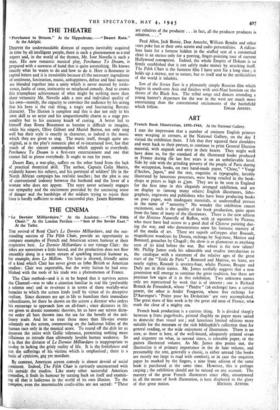French Book Illustration, 1895-1945. At the National Gallery.
ART
I HAD the impression that a number of eminent English printers were weeping in corners, at the National Gallery, on the day I visited the exhibition there. I felt that they squared their shoulders and went back to their presses, to continue to print General Election material, with anguish and envy in their hearts. They might well have done so, for the standard of the illustrated books produced in France during the last five years is on an unbelievable level. Side by side with the grinding poverty of the people of Paris during the occupation, books, on rare hand-made paper, "Chine," " Verge d'Arches, Japon," and the rest, exquisite in typography, lavishly illustrated by luxurious processes, were being retailed in the book- shops at prices as high as £3oo. They are to be seen in England for the first time in this elegantly arranged exhibition, and are on display to (among many others) English illustrators, litho- graphers, engravers and publishers who have been producing books on poor paper, with inadequate materials, at understaffed presses
_ in the name of " austerity." No wonder this exhibition causes excitement, such is the quality of the book production, quite apart from the fame of many of the illustrators. There is the new edition of the Histoire Naturelle of Buffon, with 31 aquatints by Picasso, who must have had access to a good deal of Chinese painting dur- ing the war, and who demonstrates anew his fantastic mastery of all the media of art. There are superb collotypes after Rouault, magnificent woodcuts by Derain, etchings by Segcnzac, Matisse and Bonnard, gouaches by Chagall ; the show is as glamorous as anything seen of its kind before the war. But where is the new talent? Mr. Phillip James ends his admirable and erudite intrcduction to the catalogue with a statement of the relative ages of the great stars of the " Ecole de Paris" ; Bonnard and Matisse, we learn, are nearly eighty, Rouault is seventy-four, whilst Picasso, Braque and Dufy are in their sixties. Mr. James tactfully suggests that a new generation will emerge to continue the great tradition, but there are precious few signs of it in this exhibition. Two unknown names only are represented by work that is of interest ; one is Richard Brnnck de Freundeck, whose " Phedre " (26 etchings) have a certain power, the other is Andre Fougeron, whose five etchings for D'Auvergne's Priere pour les Desherites ' are very accomplished. The great mass of fine work is by the great old men of France, who mark the close of a mighty era.
French book production is a curious thing. It is divided sharpy between 9 franc paperbacks, printed illegibly on paper more suited to domestic than visual use; luxurious limited editions more suitable for the museum or te rich bibliophile's collection than for general reading, or the wide enjoyment of illustration. There is no core, as there is here, of the well-bound, adequately printed seven and sixpenny on what, in normal times, is tolerable paper, or the guinea illustrated volume. As Mr. James also points out, the illustration is of primary importance in the de luxe volume, and presumably the text, generally a classic, is either unread (the books are mostly too large to read with comfort), or in case the exquisite paper be marked by the fingers, a nine franc edition of the same book is purchased at the same time. However, this is perhaps carping ; the exhibition should not be missed on any account. The mastery of the great French illustrators since 1895, unsurpassed in all the means of book illustration, is here displayed to the glory of that great nation.
MICHAEL AYETON.


























 Previous page
Previous page